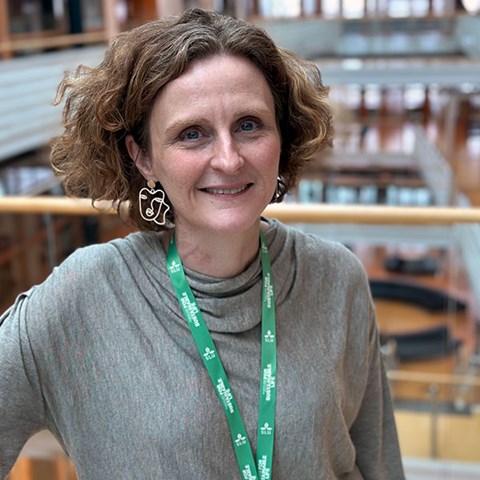Contact
Bettina Bäck, Communications Officer
Faculty of Veterinary Medicine and Animal Science, faculty office, SLU
bettina.back@slu.se, +46 18 67 30 67, +46 761 19 22 61

Visiting Professor Hedvig Kjellström believes that methods from her research field – artificial intelligence – can contribute to animal-related issues in many ways. She hopes to establish many new contacts at SLU and create new collaborations with KTH Royal Institute of Technology and other technical universities.
Hedvig Kjellström is already a familiar face at SLU thanks to her collaboration with Elin Hernlund and Pia Haubro Andersen on automatic video analysis of horse movement and behaviour. As part of her part-time visiting professorship, she intends to be on campus one day per week to establish new contacts.
– ‘I want to be a bridge between AI researchers, in part from KTH where I work but also researchers at other universities and SLU.’
One question ... What is AI? Can you give an example?
– ‘Yes, I have just the elevator pitch! The term AI is often used too broadly,’ Hedvig Kjellström explains.
AI involves methods that can independently process information, for example through sensors or text. Hedvig Kjellström continues:
– ‘This information isn’t just collected, it’s also processed. The system can reason and then make decisions. This decision can generate a text or statement such as “this is a picture of a cancer sore. It is 73 per cent likely that this sore is malignant.”
AI is already part of our everyday lives and many people use it daily on their mobile phones; Siri and Alexa are examples of AI agents.
– The algorithm listens to the user’s voice and translates it into text. That in itself is no mean feat.
Another module interprets the text. If somebody asks Siri for the weather forecast, she first needs to work out the user’s location before looking it up in the Swedish Meteorological and Hydrological Institute’s database.
The module then translates this text into synthetic speech that provides the user with weather information.
These modules use something known as “deep learning” where large neural networks have been taught to process large amounts of data.’
Collaborating with other researchers is the key to so much. Professor Emerita Pia Haubro Andersen is one of the pioneers behind systematically and objectively interpreting the facial expressions of horses to detect pain or other conditions. Hedvig contributed by automating the process using help from AI.
– ‘Pia and I were both supervisors of a doctoral student who defended their thesis last year. This collaboration is the reason why I am here as a visiting researcher.’
SLU’s AniLocoLab has motion capture sensors and a scanner that measures the animal’s entire body rather than specific points. This data is then used together with AI to generate a 3D model of the horse. A doctoral student is working with the model’s development.
– ‘This will enable us to film movement using a standard video camera and see the horse’s shape, including its weight,’ Hedvig Kjellström explains.
Now the challenge is to study and measure other species such as cats and dogs.
Do you have any pets?
– ‘No, I live in central Stockholm so it’s difficult. I grew up around cats and dogs and I’ll occasionally borrow my parents’ dog. I have also spent a lot of time horse riding and I used to be a sharer.
– The time I have spent observing and interacting with horses and dogs has been a great benefit to my research. But I don’t really understand cats,’ Hedvig says with a laugh.
Hedvig Kjellström is working on a funding application for a project that will investigate how AI can help interpret communication with cats, dogs and horses.
– ‘One important element of owning an animal is being able to understand them in order to give them a good life and increase their wellbeing.’
To be able to succeed with such a project there needs to be a collaboration between several experts with different skills such as ethologists with a deep understanding of the animal and its behaviour, veterinarians and data collection experts.
We need more basic data and to film various species in different conditions.
Hedvig Kjellström is visiting professor at the Department of Anatomy, Physiology and Biochemistry at SLU. She is based at the Division of Robotics, Perception and Learning at KTH Royal Institute of Technology. Read more on Hedvig Kjellström’s CV page.
Foto ingressbild: Bettina Bäck.
Bettina Bäck, Communications Officer
Faculty of Veterinary Medicine and Animal Science, faculty office, SLU
bettina.back@slu.se, +46 18 67 30 67, +46 761 19 22 61